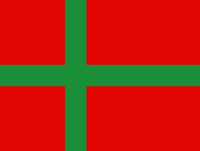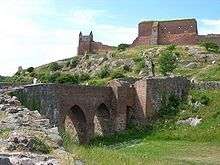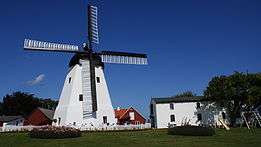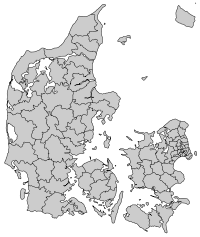Bornholm
|
Bornholm's coastline | |
 | |
| Geography | |
|---|---|
| Location | Baltic Sea |
| Coordinates | 55°8′35″N 14°55′15″E / 55.14306°N 14.92083°ECoordinates: 55°8′35″N 14°55′15″E / 55.14306°N 14.92083°E |
| Area | 589.16 km2 (227.48 sq mi) |
| Highest elevation | 162 m (531 ft) |
| Highest point | Rytterknægten |
| Administration | |
| Region | Capital Region of Denmark |
| Municipality | Bornholm |
| Largest settlement | Rønne (pop. 13,639) |
| Demographics | |
| Population | 39,684 (1 April 2016) |
| Pop. density | 67.47 /km2 (174.75 /sq mi) |
Bornholm ([bɒːnˈhʌlˀm]; Old Norse: Burgundaholmr) is a Danish island in the Baltic Sea, to the east of the rest of Denmark, south of Sweden, northeast of Germany and north of the westernmost part of Poland. The main industries on the island include fishing, dairy farming, and arts and crafts such as glass production and pottery using locally worked clay. Tourism is important during the summer. There is an especially large number of Denmark's round churches on the island.
The island is called Solskinsøen (The Sunshine Island) because of its weather and Klippeøen (The Rock Island) because of its geology. The heat from the summer is stored in the rock formations and the weather is quite warm until October. The island's topography consists of dramatic rock formations in the north (unlike the rest of Denmark, which is mostly gentle rolling hills) sloping down towards pine and deciduous forests (greatly affected by storms in the 1950s), farmland in the middle and sandy beaches in the south.[1]
Strategically located in the Baltic Sea, Bornholm has been fought over for centuries. It has usually been ruled by Denmark, but also by Lübeck and Sweden. The ruin of Hammershus, at the northwestern tip of the island, is the largest medieval fortress in northern Europe, testament to the importance of its location.
Bornholm Regional Municipality, established January 2003 by the merger of Bornholm County with 5 municipalities, covers the entire island. Bornholm was one of the three last Danish municipalities (Danish: (singular) kommune; kommuner (plural)) not belonging to a county — the others were Copenhagen and Frederiksberg. On 1 January 2007, the municipality lost its short-lived (2003 until 2006) county status and became part of the Capital Region of Denmark.
The island is situated between 54/59/11 and 55/17/30 northern latitude and 14/45 and 15/11 eastern longitude.
Directly west of Bornholm across the Baltic Sea mostly on the island of Sjælland are several municipalities of Region Sjælland: Stevns, Faxe, Næstved (the part that used to be the municipality of Fladså) and Vordingborg, including Møn, which is around 135 km (84 mi) across the Baltic Sea.
It typically takes 3 hours for passengers and freight (ferry:2 hours;driving:1 hour) to travel between Rønne and Copenhagen via Ystad in Sweden. There is a ferry departure strictly reserved for freight of goods between Rønne and Køge. Travel time for the freight ferry route is:?. There are also ferry routes to Sassnitz and Swinoujscie. Between Bornholm Airport and Copenhagen Airport by airplane it is 25 minutes.
The Ertholmene archipelago is located 18 km (11 mi) to the northeast of Bornholm. These islands, which do not belong to a municipality or region, are administered by the Danish Ministry of Defence.
Language
Many inhabitants speak the Bornholmsk dialect, which is officially a dialect of Danish.[2] Bornholmsk retains three grammatical genders, like Icelandic and most dialects of Norwegian, but unlike standard Danish. Its phonology includes archaisms (unstressed [a] and internal [d̥, ɡ̊], where other dialects have [ə] and [ð̞, ʊ / ɪ]) and innovations ([tɕ, dʝ] for [kʰ, ɡ̊] before and after front-tongue vowels). This makes the dialect difficult to understand for some Danish speakers. However, Swedish speakers often consider Bornholmian to be easier to understand than standard Danish. The intonation resembles the Scanian dialect spoken in nearby Scania, the southernmost province of Sweden.
Municipality
| Municipality | Yes | No | ||
|---|---|---|---|---|
| Votes | Percent | Votes | Percent | |
| Allinge-Gudhjem | 3590 | 74 | 1287 | 26 |
| Hasle | 2886 | 70 | 1219 | 30 |
| Nexø | 3218 | 59 | 2252 | 41 |
| Rønne | 7754 | 85 | 1366 | 15 |
| Aakirkeby | 3131 | 74 | 1118 | 26 |
| Total:27821 | 20579 | 74 | 7242 | 26 |



Bornholm Regional Municipality is the local authority (Danish, kommune) covering the entire island. It is the result of a merger of the five former (1 April 1970 until 2002) municipalities on the island (Allinge-Gudhjem, Hasle, Nexø, Rønne and Aakirkeby) and the former Bornholm County. The island had 22 municipalities until March 1970, of which 6 were market towns and 16 parishes. In addition to supervising parish municipalities, which was the responsibility of the counties in all of Denmark, the market town municipalities of Bornholm were supervised by Bornholm County as well and not by the Interior Ministry as was the case in the rest of Denmark.The seat of the municipal council is the island's main town, Rønne. The voters decided to merge the county with the municipalities in a referendum May 29, 2001, effective from January 1, 2003. On the ballot was written the question, "Do you want the six municipal entities of Bornholm to be joined to form one municipal entity as of 1 January 2003?" 73.9% of those voting ticked off the box "Ja" (English, Yes) on the ballot. The lowest percentage for the merger was in Nexø municipality, whose mayor, Annelise Molin, a Social Democrat, spoke out against the merger. It was required that each municipality had more "Yes" votes than "No" votes. Otherwise the merger would have to be abandoned altogether. The six municipal entities had 122 councillors (of which county clls were 15) and the new regional municipality would have 27 councillors from the start. They will be reduced to 23 from 1 January 2018 (election November 2017). The merger was approved in a law by the Folketing 19 March 2002, transferring the tasks of the abolished county and old municipalities to the new Bornholm Regional Municipality. The first regional mayor was Thomas Thors, a physician and member of the Social Democrats and previously mayor of Rønne Municipality. Bjarne Kristiansen, representing the local Borgerlisten political party, served as mayor from January 1, 2006 until 2009. From January 1, 2010 the mayor has been Winni Grosbøll, a high school teacher and a member of the Social Democrats (Socialdemokratiet) political party.
Ferry services connect Rønne to Świnoujście (Poland), Sassnitz (Germany), Køge (near Copenhagen, Denmark); and catamaran services to Ystad (Sweden). Simrishamn (Sweden) has a ferry connection during the summer. There are also regular catamaran services between Nexø and the Polish ports of Kołobrzeg, Łeba and Ustka. There are direct train and bus connections Ystad-Copenhagen, coordinated with the catamaran. There are also flights from Bornholm Airport to Copenhagen and other locations.
Bornholm Regional Municipality was not merged with other municipalities on 1 January 2007 in the nationwide Municipal Reform of 2007.
Towns and villages
The larger towns on the island are located on the coast and have harbours. There is however one exception, centrally placed Aakirkeby. The largest town is Rønne, the seat, in the southwest. The other main towns (clockwise round the island) are Hasle, Allinge-Sandvig, Gudhjem, Svaneke and Nexø. Monday morning 22 September 2014 it was documented by Folkeregistret in the municipality that the number of people living in the municipality that day were 39,922, the lowest number in over 100 years.[4]
As of 2016, the Danish statistical office gave the populations as follows:[5]
|
|
|
Other localities (with approximate populations, not updated) include Aarsballe (86), Arnager (151), Olsker (67), Rutsker (64), Rø (181), Stenseby (?) and Vang (92).
History

In Old Norse the island was known as Borgundarholm, and in ancient Danish especially the island's name was Borghand or Borghund; these names were related to Old Norse borg "height" and bjarg/berg "mountain, rock", as it is an island that rises high from the sea.[6] Other names known for the island include Burgendaland (9th century), Hulmo / Holmus (Gesta Hammaburgensis ecclesiae pontificum), Burgundehulm (1145), and Borghandæholm (14th century).[7] The Old English translation of Orosius uses the form Burgenda land.[8] Some scholars[9] believe that the Burgundians are named after Bornholm; the Burgundians were Germanic peoples who moved west when the Western Roman Empire collapsed and occupied and named Burgundy in France.
Bornholm formed part of the historical Lands of Denmark when the nation united out of a series of petty chiefdoms. It was originally administratively part of the province of Scania and was administered by the Scanian Law after this was codified in the 13th century. Control over the island evolved into a long-raging dispute between the See of Lund and the Danish crown culminating in several battles. The first fortress on the island was Gamleborg which was replaced by Lilleborg, built by the king in 1150. In 1149, the king accepted the transfer of three of the island's four herreder (districts) to the archbishop. In 1250, the archbishop constructed his own fortress, Hammershus. A campaign launched from it in 1259 conquered the remaining part of the island including Lilleborg. The island's status remained a matter of dispute for an additional 200 years.
Bornholm was pawned to Lübeck for 50 years starting 1525. Its first militia, Bornholms Milits, was formed in 1624.
Swedish forces conquered the island in 1645, but returned the island to Denmark in the following peace settlement. After the war in 1658, Denmark ceded the island to Sweden under the Treaty of Roskilde along with the rest of the Skåneland, Bohuslän and Trøndelag, and it was occupied by Swedish forces.
A revolt broke out the same year, culminating in Villum Clausen's shooting of the Swedish commander Johan Printzensköld on 8 December 1658.[10] Following the revolt, a deputation of islanders presented the island as a gift to King Frederick III on the condition that the island would never be ceded again. This status was confirmed in the Treaty of Copenhagen in 1660.
Swedes, notably from Småland and Skania, emigrated to the island during the 19th century, seeking work and better conditions. Most of the migrants did not remain.

German occupation (1940–1945)
Bornholm, as a part of Denmark, was captured by Germany on April 10, 1940, and served as a lookout post and listening station during the war, as it was a part of the Eastern Front. The island's perfect central position in the Baltic Sea meant that it was an important "natural fortress" between Germany and Sweden, effectively keeping submarines and destroyers away from Nazi-occupied waters. Several concrete coastal installations were built during the war, and several coastal batteries had tremendous range. However, none of them were ever used, and only a single test shot was fired during the occupation. These remnants of Nazi rule have since fallen into disrepair and are mostly regarded today as historical curiosities. Many tourists visit the ruins each year, however, providing supplemental income to the tourist industry.
On 22 August 1943 a V-1 flying bomb (numbered V83, probably launched from a Heinkel He 111) crashed on Bornholm during a test – the warhead was a dummy made of concrete. This was photographed or sketched by the Danish Naval Officer-in-Charge on Bornholm, Lieutenant Commander Hasager Christiansen. This was the first sign British Intelligence saw of Germany's aspirations to develop flying bombs and rockets which were to become known as V-1 and V-2.
Soviet occupation (1945–1946)
Bornholm was heavily bombarded by the Soviet Air Force in May 1945. German garrison commander, German Navy Captain Gerhard von Kamptz, refused to surrender to the Soviets, as his orders were to surrender to the Western Allies. The Germans sent several telegrams to Copenhagen requesting that at least one British soldier should be transferred to Bornholm, so that the Germans could surrender to the western allied forces instead of the Russians. When von Kamptz failed to provide a written capitulation as demanded by the Soviet commanders, Soviet aircraft relentlessly bombed and destroyed more than 800 civilian houses in Rønne and Nexø and seriously damaged roughly 3,000 more on 7–8 May 1945.
During the Russian bombing of the two main towns on 7 and 8 May, Danish radio was not allowed to broadcast the news because it was thought it would spoil the liberation festivities in Denmark.[11] On 9 May Soviet troops landed on the island, and after a short fight, the German garrison (about 12,000 strong[12]) surrendered.[13] Soviet forces left the island on 5 April 1946.
After the evacuation of their forces from Bornholm, the Soviets took the position that the stationing of foreign troops on Bornholm would be considered a declaration of war against the Soviet Union, and that Denmark should keep troops on it at all times to protect it from such foreign aggression. This policy remained in force after NATO was formed, with Denmark as a founding member. The Soviets accepted the stationing there of Danish troops, which were part of NATO but viewed as militarily inferior elements of the alliance, but they strongly objected to the presence of other NATO troops on Bornholm, in particular of US troops.[14]
This situation caused diplomatic problems at least twice: Once when an American helicopter landed outside the town of Svaneke due to engine problems in a NATO exercise across the Baltic Sea, and once again (around the year 2000), when the Bornholms Værn (Bornholm Guard) was disbanded, becoming part of the Guard Hussar Regiment. The Danish government suggested shutting down Almegårds Kaserne, the local barracks, since "the island could quickly be protected by troops from surrounding areas and has no strategic importance after the fall of the Iron Curtain".
Sights and landmarks

On the surface of Bornholm older geological formations can be seen than in the rest of Denmark. Stubbeløkken and Klippeløkken granite quarries in Knudsker parish just east of central Rønne - and statistically a part of the town - are among the few remaining quarries of what was once many active quarries on the island. The island's varied geography and seascapes attract visitors to its many beauty spots from the Hammeren promontory in the northwest to the Almindingen forest in the centre and the Dueodde beaches in the southeast. Of special interest are the rocky sea cliffs at Jons Kapel and Helligdomsklipperne, the varied topography of Paradisbakkerne and rift valleys such as Ekkodalen and Døndalen.[15] Bornholm's numerous windmills include the post mill of Egeby and the well-kept Dutch mill at Aarsdale. The lighthouse at Dueodde is Denmark's tallest, while Hammeren Lighthouse stands at a height of 85 metres (279 ft) above sea level and Rønne Lighthouse rises over the waterfront.[16]
Examples of roads that have (very) steep climbs and descents are: (inland) Simblegårdsvej in Klemensker, which begins by the village inn Klemens Kro, and Slamrebjergvej just outside Nexø extending northward from the main road from Rønne. Along the coast there are several steep roads, which is also the case in some parts of Denmark as a whole, for instance in and around Vejle.[17]
The island hosts examples of 19th- and early-20th-century architecture, and about 300 wooden houses in Rønne and Nexø, donated by Sweden after World War II, when the island was repairing damage caused by the war. The island is home to 15 medieval churches, four of which are round churches with unique artwork and architecture. The ancient site of Rispebjerg has remains of sun temples from the Neolithic and earthworks from the Iron Age.[18]
There are 14 European bison near Åkirkeby, attracting 100,000 visitors a year.[19][20]
Famous people
The Danish painter Oluf Høst was born in Svaneke in 1884, and the Danish cultural historian Vilhelm Grønbech was born in Allinge in 1873.
The Danish writer and painter Gustaf Munch-Petersen moved to Bornholm in 1935 and married Lisbeth Hjorth while living on the island.
At age 8, socialist writer Martin Andersen Nexø moved to the island, and took his last name after the city of Nexø on its east coast.
M.P. Möller (1854–1937), a pipe-organ builder and manufacturer, was born in Østermarie before moving to the United States.[21]
Gertrud Vasegaard (1913–2007), a ceramist remembered for her stoneware, was born in Rønne and established a workshop in Gudhjem.[22]
Bornholm also attracted many famous artists at the beginning of the 20th century, forming a group now known as the Bornholm school of painters. In addition to Oluf Høst, they include Karl Isaksson (1878–1922), from Sweden, and the Danes Edvard Weie (1879-1943), Olaf Rude (1886–1957), Niels Lergaard (1893–1982), and Kræsten Iversen (1886–1955).[23]
In the mid 1940s Donald (descendant of Ben Sayers) and Mavis Sayers arrived in Bornholm on a boat from Copenhagen. On their arrival they were greeted by a band and were paraded into the town centre. They were celebrated by the locals as the first English people to visit Bornholm since the end of the war and were treated like royalty during their stay. Following their stay they were frequently invited back as they were seen as a symbol of the restoration of Bornholm.
Electricity supply
Bornholm is connected to the Swedish electricity grid by a submarine 60 kV AC cable, which is among the longest AC cables in Europe. This cable is capable of delivering all the electrical energy consumed on Bornholm. However Bornholm also generates its own electricity at small thermal power plants and especially wind turbines.
Bornholm is also home to a large internationally funded demonstration project to test the viability of novel energy market mechanisms to regulate energy networks with a high prevalence of renewables (such as wind turbines and photovoltaics). 50% of the project is EU-funded, with the remainder coming mainly from large corporations. See http://www.eu-ecogrid.net/ecogrid-eu for more.
Population
 Østerlars Church, one of Bornholm's four round churches  Ruins of Hammershus, a medieval fortress 22 September 2014 population numbers showed less than 40,000 inhabitants on the island for the first time in over 100 years. The Folkeregister in the municipality could document 39,922 inhabitants in the municipality on that date.[24] ClimateBornholm has an oceanic climate relatively similar to southern Sweden and mainland Denmark, whose summer highs and winter lows are heavily moderated by its maritime and isolated position. Even though heat is rare, the climate is sunny during summers and rainfall is generally sparse for a climate of this type. The winter (November–December) 2010 - (January–April) 2011 was exceptionally extreme with snow depth reaching an average of 146 cm, 2 inches short of 5 feet (snowdrifts 6 meters, almost 20 feet) the highest in Northern Europe. Military had to assist. The DMI estimated the weight of snow to be 100 million ton. 2013 was a cold year, with only June, July, and August being warm.
SportsBornholm's geography as an island and moderate climate makes Bornholm an ideal location for sailing and other water-based sports. Bornholm has also become an internationally recognised venue for 'match racing', a sailing sport where two identical (or one design) supplied racing yachts are raced in one-on-one dogfights on the water. The Danish Open event was held in Bornholm in September 2010 at the port town of Rønne on the Western coast of Bornholm. The racing yachts used for the Danish Open event are Danish-designed DS37 racing yachts. These highly manoeuvrable and versatile boats are also used in the Match Cup Sweden event. The five-day Danish Open is a key event in the World Match Racing Tour calendar which is one of only 3 events awarded 'special event' status by the International Sailing Federation. The Tour is the world's leading professional 'match racing' series and features a nine-event calendar which crosses three continents during the series. Points accrued during the Danish Open contribute directly to the World Match Racing Tour championship with the winner of the season finale at the Monsoon Cup in Malaysia claiming the ultimate match racing title ISAF World Match Racing Champion. Unlike other sailing sports, match racing is suited to locations like Bornholm, because it takes place in close proximity to the shore which provides spectacular heat-of-the-action viewing for the on-shore audience. There two small stadiums: Nexø Stadion, in Nexø, where NB Bornholm association football club play; and the slightly larger multi-use stadium Rønne Stadion Nord in Rønne, which serves the Bornholm national football team, multi-section club most well known for athletics IK Viking, and several local football clubs. The DBU Bornholm is the local branch governing football on the island. ReligionVarious Christian denominations have become established on the island, most during the 19th century.
Cultural references
See also
ReferencesIn-line
General
Further reading
External links
| ||||||||||||||||||||||||||||||||||||||||||||||||||||||||||||||||||||||||||||||||||||||||||||||||||||||||||||||||||||||||||||||||||||||||||||||||||||||||||||||||||||||||||||||||||||||||||||||||||||||||||||||||||||||||||||||||||||||||


